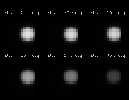 |
Every several days, Mars Pathfinder
will image the sunrise and sunset on Mars. Future images will show a larger
area -- we have a higher data rate than we expected when we planned this
image, so we can get more information. Images taken at sunset, like this,
and up to two hours later, will be used to investigate the distribution
of dust within the Martian atmosphere. Already, we can see some dust
layers in the images. By seeing how the twilight fades with time -- it
lasts for over two hours -- we can determine that the dust extends high
into the atmosphere.
 Our
observations of the Sun using the IMP camera showed more dust in the martian
atmosphere than was expected. In fact, the amount of dust ("optical depth"
of 0.4, to scientists) was comparable to Viking observations during clear
(non-dust-storm) times. The measurements were made by taking images of
the Sun with different colors and with the Sun at different elevations
in the sky. As the Sun goes lower in the sky the light passes through more
and more dust, becoming fainter and fainter, and allowing the amount of
dust to be measured. Our
observations of the Sun using the IMP camera showed more dust in the martian
atmosphere than was expected. In fact, the amount of dust ("optical depth"
of 0.4, to scientists) was comparable to Viking observations during clear
(non-dust-storm) times. The measurements were made by taking images of
the Sun with different colors and with the Sun at different elevations
in the sky. As the Sun goes lower in the sky the light passes through more
and more dust, becoming fainter and fainter, and allowing the amount of
dust to be measured.
On Mars, the dust intercepts essentially the same
amount of sunlight in different colors. The reddish color of the sky is
because the blue light is absorbed by the dust, but the red light is scattered
throughout the sky. By contrast, the molecules in the Earth's atmosphere
intercept about as much of the blue sunlight as the Mars dust does, because
blue light is scattered easily by Earth's atmosphere (and red light is
not, giving the Earth its blue sky).
In future days, scientists will monitor the amount
of dust in the atmosphere, and they will try to measure absorption by water
vapor with a similar technique. Using other observations of the sky, scientists
will measure the size and shape of the dust particles and try to determine
how high in the atmosphere the dust extends. On some days, IMP will perform
a cloud search, looking for clouds passing over the landing site. The Hubble
Space Telescope will also observe Mars on some of the same days, so large
clouds--if they are present--may be seen simultaneously from the Earth
and from Mars. |



